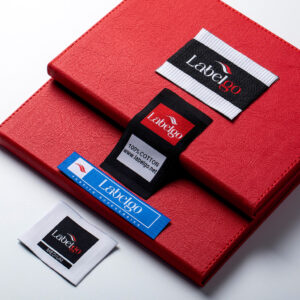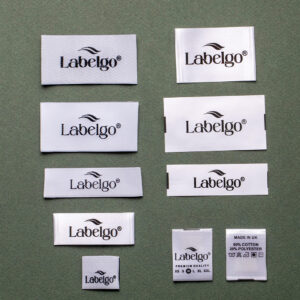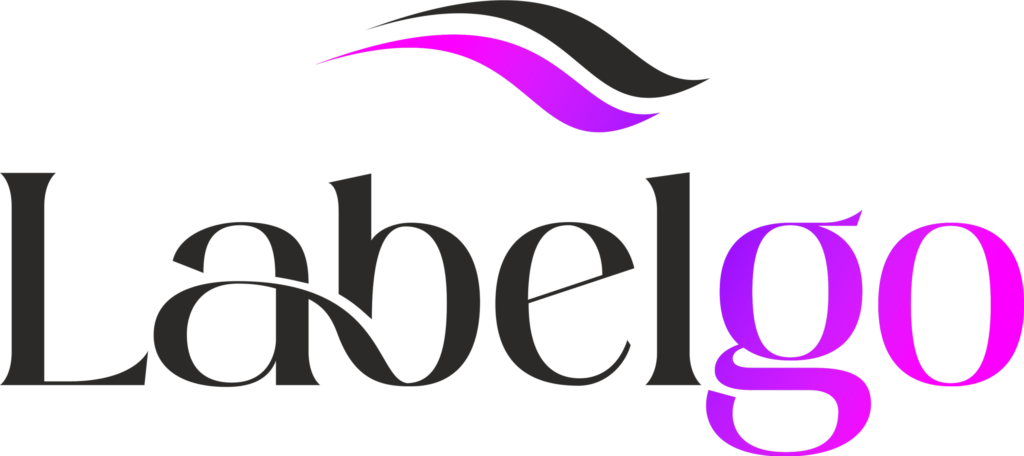Woven labels are indispensable for brands seeking to convey quality and sophistication. They are the best way to brand clothing permanently. Unlike printed labels, which can fade or crack over time, the woven design maintains its integrity throughout the product’s life. They are often a key element in establishing a recognizable fashion brand and are a clear indicator of garment quality.
For more insights, read “How Do Woven Labels Reflect the Quality of Your Brand?” and “What Are Woven Labels? A Complete Guide”.

Types of Woven Labels
The primary distinction between woven label types lies in how they are finished, or “cut and folded,” which determines how they are attached to the product:
1. Flat/Straight Cut Labels
These labels are woven and then cut on all four sides. They are attached by sewing all four edges down, typically inside garments (like near the neck or hem) where a fully sewn-down label is desired.
2. End Fold Labels
The two short ends are folded underneath the label. This creates a clean, soft edge that is then sewn into the seam or onto the garment. This is one of the most common styles for neck labels, as the folded ends prevent fraying and provide a comfortable feel against the skin.
3. Center Fold/Loop Fold Labels
The label is folded exactly in the middle. The folded edge is usually sewn into a seam (like the neckline or waistband), with the two open ends hanging down inside the garment. This style allows information to be displayed on both the front and back of the label and is ideal for care instructions (see “What Are Care Labels and Why Are They Legally Required?”) or brand details.
4. Book Fold Labels
In this fold type, both the top and bottom edges of the label are folded toward the center. This allows for visuals or information on both sides of the label (front and back), with the folds creating a clean “book spine” appearance that can be secured into a seam.
5. Manhattan Fold Labels
This is a variation of the center fold where the center is folded, and then the top is also folded down, creating a flap-like shape. It provides a highly unique and premium presentation, often sewn into a seam or pocket.

Woven Label Qualities (Weaves)
The quality and detail of a woven label are primarily determined by the type of weave used, which affects the resolution, feel, and cost.
1. Taffeta Weave (Standard)
Description: This is the most common and economical weave. It has a basic, flat, slightly ribbed appearance, similar to standard shirt fabric.
Detail: It offers good detail but is less fine than damask. Lines and letters can appear slightly thicker.
Feel: The texture is smooth but not as soft as damask.
Best For: Simple logos, care labels, size labels, and large text.
2. Satin Weave
Description: The yarns are woven in a way that gives the label a noticeable sheen or gloss, much like satin fabric.
Detail: Offers good clarity, but the shine is the main feature. The background is often satin while the text or logo is taffeta or damask.
Feel: Very smooth, soft, and luxurious.
Best For: High-end lingerie, delicate garments, or anywhere a shiny, upscale look is desired.
3. Damask Weave (High-Definition)
Description: This is the highest quality and most intricate weave. It uses thinner yarns and a denser weaving pattern (high-density), allowing for greater color complexity and detail.
Detail: Provides the sharpest definition, finest lines, and smallest lettering possible, perfect for complex logos, gradients, or very small print.
Feel: Exceptionally soft and fine, often preferred for labels that touch the skin.
Best For: Premium clothing lines, complex logos, detailed artwork, and anything requiring a high-end, comfortable finish. This quality truly helps the label reflect the quality of your brand.
Choosing the right type and quality is crucial for your product’s overall appeal. To get started on designing the perfect representation for your brand, check out our “Step-by-Step Guide to Designing Your Perfect Woven Label”.
